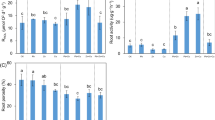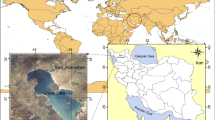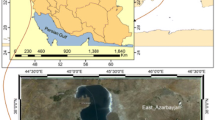Abstract
In the present day, plants are increasingly being utilized to safeguard the environment. In this study, we used Salsola crassa M. B. and Suaeda maritima L. Dumort for phytoremediation of water contaminated with heavy metals and simultaneous examination of the effect of industrial pollution on their root structures. After irrigation of a treatment group with wastewater and a control group with fresh water for 3 months, we fixed the root parts in the FAA fixator for developmental study, and measured the concentrations of Co, Ni, Zn, As, Cu, and Pb in the roots, shoots, soil, and irrigating water. The plants irrigated with wastewater showed significant accumulation of heavy metals in the roots and some translocation of heavy metals from the roots to the shoots. We also performed an experiment with two 0.3 m3 pools to more closely study the feasibility of these plants for filtering water of contaminants, including mineral compounds, and altering its chemical characteristics. In our anatomical studies, the cells of the treatment roots showed irregularities and abnormal appearances in all tissue layers. The diameter and area of the xylem and the size of the cortical parenchyma have increased in the treatment plants of both species, confirmed by Stereolite software. Phytoremediation studies indicated that S. crassa accumulated As, Cu, Zn, Pb, Co, and Ni, and S. maritima accumulated As, Co, Zn, and Cu. S. crassa accumulated more heavy metals in its roots, whereas S. maritima accumulated more in its shoots. The biological oxygen demand and chemical oxygen demand were also significantly reduced in the wastewater passed through pools with S. crassa. Our results indicate that both genera are hyperaccumulators of heavy metals and therefore hold promise for industrial wastewater treatment, especially the absorption of As.














Similar content being viewed by others
References
Arora, S., Patel, P. N., Vanza, M. J., & Rao, G. G. (2014). Isolation and characterization of endophytic bacteria colonizing halophyte and other salt tolerant plant species from coastal Gujarat. African Journal of Microbiology Research, 8(17), 1779–1788.
Baker, A. J. M., Reeves, R. D., & Hajar, A. S. M. (1994). Heavy metal accumulation and tolerance in British population of the metallophyte Thalaspi caerulesens J. and C. Presl (Brassicaeae). The New Phytologist, 127, 61–68.
Barberon, M., & Geldner, N. (2014). Radial transport of nutrients: the plant root as a polarized epithelium. Plant Physiology, 166, 528–537.
Bareen, F.-e., & Tahira, S. A. (2011). Metal accumulation potential of wild plants in tannery effluent contaminated soil of Kasur, Pakistan: field trials for toxic metal cleanup using Suaeda fruticosa. Journal of Hazardous Materials, 186(1), 443–450.
Cao, X., & Ma, L. Q. (2004). Effects of compost and phosphate on plant arsenic accumulation from soils near pressure-treated wood. Environmental Pollution, 132(3), 435–442.
Cao, X., Ma, L. Q., & Shiralipour, A. (2003). Effects of compost and phosphate amendments on arsenic mobility in soils and arsenic uptake by the hyperaccumulator, Pteris vittata L. Environmental Pollution, 126(2), 157–167.
Cristaldi, A., Oliveri, C. G., Jho, E. H., Zuccarello, P., Grasso, A., Copat, C., & Ferrante, M. (2017). Phytoremediation of contaminated soils by heavy metals and PAHs. A brief review. Environmental Technology and Innovation, 8, 309–326.
D’Alessandro, D., Arletti, S., Azara, A., Buffoli, M., Capasso, L., Cappuccitti, A., Casuccio, A., Cecchini, A., Costa, G., De Martino, A. M., Dettori, M., Di Rosa, E., Fara, G. M., Ferrante, M., Giammanco, G., Lauria, A., Melis, G., Moscato, U., Oberti, I., Patrizio, C., Petronio, M. G., Rebecchi, A., Romano Spica, V., Settimo, G., Signorelli, C., & Capolongo, S. (2017). Strategies for disease prevention and health promotion in urban areas: the Erice 50 charter. Annali Di Igiene Medicina Preventiva E Di ComunitàISSN: 1120–9135, 29(6), 481–493. https://doi.org/10.7416/ai.2017.2179.
El-Ghamery, A. A., Sadek, A. M., & Abd Elbar, O. H. (2015). Root anatomy of some species of Amaranthus (Amaranthaceae) and formation of successive cambia. Annals of Agricultural Science, 60(1), 53–60.
Eslamzadeh, T. (2006). Salicornia europeae, a bioaccumulator in Maharloo salt lake region. International Journal of Soil Science, 1(1), 75–80.
Fahn, A., & Zimmermann, M. H. (1982). Development of successive cambia in Atriplex halimus (Chenopodiaceae). Botanical Gazette, 143, 353–357.
Ghosh, M., & Singh, S. P. (2005). A review on phytoremediation of heavy metals and utilization of its by-products. Applied Ecology and Environmental Research, 3, 1–18.
Gomes, M. P., de Sá e Melo Marques, T. C. L. L., de Oliveira Gonçalves Nogueira, M., de Castro, E. M., & Soares, Â. M. (2011). Ecophysiological and anatomical changes due to uptake and accumulation of heavy metal in Brachiaria decumbens. Scientia Agricola (Piracicaba, Braz.), 68(5), 566–573.
Grigore, M. N., Toma, C. (2007). Histo-anatomical strategies of chenopodiaceae halophytes: adaptive, ecological and evolutionary implications. WSEAS Transcriptions on Biology and Biomedicine, 4(12), 204-218.
Grigore, M. N., Ivanescu, L., & Toma, C. (2014). Halophytes: an integrative anatomical study. Springer International Publishing. https://doi.org/10.1007/978-3-319-05729-3.
Hossain, M. A., Piyatida, P., da Silva, J. A. T., & Fujita, M. (2012). Molecular mechanism of heavy metal toxicity and tolerance in plants: central role of glutathione in detoxification of reactive oxygen species and methylglyoxal and in heavy metal chelation. Journal of Botany, 2012, 1–37.
Ji, J. (2015). Research status on Suaeda heteroptera Kitag. Aquatic Science and Technology, 3(2), 23–32.
Kraehmer, H., & Baur, P. (2013). In: Weed anatomy (Vol. 8, p. 258). A John Wiley & Sons, Ltd. Publication. https://doi.org/10.1002/9781118503416
Krzesłowska, M. (2011). The cell wall in plant cell response to trace metals: polysaccharide remodeling and its role in defense strategy. Acta Physiologiae Plantarum, 33, 35–51.
Kurkova, E. B., Myasoedov, N. A., Kotov, L. M., Lunkov, R. V., Shamsutdinov, N. Z., & Balnokin, Y. V. (2002). Specific structure of root cells of the salt-accumulating halophyte Suaeda altissima L. Doklady Biological Sciences, 387(1), 573–576.
Lou, L. Q., Ye, Z. H., Lin, A. J., & Wong, M. H. (2010). Interaction of arsenic and phosphate on their uptake and accumulation in Chinese brake fern. International Journal of Phytoremediation, 12(5), 487–502.
Lutts, S., & Lefevre, I. (2015). How can we take advantage of halophyte properties to cope with heavy metal toxicity in salt-affected areas? Annals of Botany, 115, 509–528.
Maestri, E., & Marmiroli, N. (2011). Transgenic plants for phytoremediation. International Journal of Phytoremediation, 1, 264–279.
Manousaki, E., & Kalogerakis, N. (2011). Halophytes present new opportunities in phytoremediation of heavy metals and saline soils. Industrial and Engineering Chemistry Research, 50, 656–660.
Odjegba, V. J., & Fasidi, I. O. (2007). Phytoremediation of heavy metals by Eichhornia crassipes. The Environmentalist, 27(3), 349–355.
Ostroumov, S. A., & Shestakova, T. V. (2009). Decreasing the measurable concentrations of Cu, Zn, Cd, and Pb in the water of the experimental systems containing Ceratophyllum demersum: the phytoremediation potential. Doklady Biological Sciences, 428, 444–447.
Peer, W., Baxter, I., Richards, E., Freeman, J., & Murphy, A. (2005). Phytoremediation and hyperaccumulator plants. In M. J. Tamás & E. Martinoia (Eds.), Molecular biology of metal homeostasis and detoxification. (Topics in current genetics) (Vol. 14, pp. 299–340). Berlin: Springer.
Pilon-Smits, E. A. H. (2005). Phytoremediation. Annual Review of Plant Biology, 56, 15–39.
Purakayastha, T. J., Viswanath, T., Bhadraray, S., Chhonkar, P. K., Adhikari, P. P., & Suribabu, K. (2008). Phytoextraction of zinc, copper, nickel and lead from a contaminated soil by different species of Brassica. International Journal of Phytoremediation, 10(1), 61–72.
Redondo-Gomez, S., Mateos-Naranjo, E., Vecino-Bueno, I., & Feldman, S. R. (2011). Accumulation and tolerance characteristics of chromium in a cord grass Cr-hyperaccumulator, Spartina argentinensis. Journal of Hazardous Materials, 185(2–3), 826–829.
Rice, E. W., Baird, R. B., Eaton, A. D., & Clesceri, L. S. (2012). Standard methods for the examination of water and wastewater. Washington DC: American Public Health Association/American Water Works Association/Water Environment Federation.
Rosa, G., Peralta-videa, J. R., Montes, M., & Parsons, J. L. (2004). Cadmium uptake and translocation in tumbleweed (Salsola Kali) a potential Cd-hyperaccumulator desert plant species: ICP/OES and XAS studies. Chemosphere, 55, 1159–1168.
Ruzin, S. E. (1999). Plant microtechnique and microscopy (pp. 322). Oxford, New York: Oxford University Press.
Shekhawat, V. P. S., Kumar, A., & Neumann, K. H. (2006). Bio-reclamation of secondary salinized soils using halophytes. In M. Öztürk, Y. Waisel, M. A. Khan, & G. Görk (Eds.), Biosaline agriculture and salinity tolerance in plants (pp. 147–154). Switzerland: Birkhäuser Basel.
Usha Shri, P., & Pillay, V. (2017). Excess of soil zinc interferes with uptake of other micro and macro nutrients in Sorghum bicolor (L.) plants. Indian Journal of Plant Physiology, 22(3), 304–308.
Vlatko, K., SlaDana, K., Miljan, B., Dijana, D., & Nada, B. (2014). Bioaccumulation and translocation of heavy metals by Ceratophyllum demersum from the Skadar Lake, Montenegro. Journal of the Serbian Chemical Society, 79(11), 1445–1460.
Yoon, J., Cao, X., Zhou, Q., & Ma, L. Q. (2006). Accumulation of Pb, Cu, and Zn in native plants growing on a contaminated Florida site. The Science of the Total Environment, 368, 456–464.
Acknowledgments
The authors wish to thank Mr. H. Argasi at the Research Consultation Center (RCC) at Shiraz University of Medical Sciences for his invaluable assistance in editing this manuscript.
Author information
Authors and Affiliations
Corresponding author
Ethics declarations
Conflict of interest
The authors declare that they have no conflict of interest.
Additional information
Publisher’s note
Springer Nature remains neutral with regard to jurisdictional claims in published maps and institutional affiliations.
Rights and permissions
About this article
Cite this article
Mohammadi Jahromi, N.S., Jonoubi, P., Majd, A. et al. Root structural changes of two remediator plants as the first defective barrier against industrial pollution, and their hyperaccumulation ability. Environ Monit Assess 191, 148 (2019). https://doi.org/10.1007/s10661-019-7240-7
Received:
Accepted:
Published:
DOI: https://doi.org/10.1007/s10661-019-7240-7




